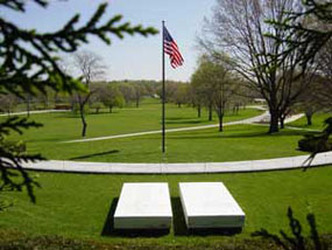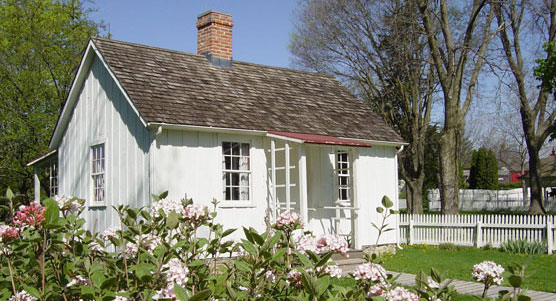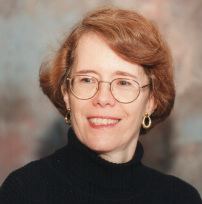The Herbert Hoover Presidential Library and Museum
The Library and Museum is located within the Herbert Hoover National Historic Site, a 187-acre park administered by the National Park Service. It is 10 miles east of Iowa City, Iowa, just off Interstate 80 at Exit 254. It is open seven days a week, from 9 a.m. to 5 p.m., except New Year's Day, Thanksgiving and Christmas Day. The Research Room is open from 8:45 a.m. to noon and 12:30 to 4:45 p.m. It is closed on weekends and federal holidays.
210 Parkside Drive
West Branch, Iowa 52358
319-643-5301
(For more information on entrance fees, see the website: www.hoover.archives.gov/)
Inside the Library and Museum
The library and museum are laid out chronologically.
The first gallery of exhibits looks at Hoover’s boyhood and his work as a mining engineer in Australia and China.
Next is a room devoted to his humanitarian efforts in Belgium before World War I and his work as President Wilson’s director of food administration at home during the war.
The third gallery takes the visitor through the Roaring Twenties.
The title of the fourth gallery is “The Wonder Boy,” and here you see the work that Hoover accomplished as secretary of commerce.
From there comes the exhibits on his candidacy for president, and following that is a gallery called “The Great Depression” filled with photographs and memorabilia related to that awful event in American history.
Sadly, the next gallery is “From Hero to Scapegoat,” depicting Hoover’s presidency.
There is a gallery devoted to Lou Hoover, Herbert’s wife, and the last exhibit titled “Counselor to the Republic” focuses on the former president’s work as one of President Truman’s envoys to Europe after World War II, and his efforts as head of the Hoover Commission to make the federal government more efficient.
Outside the Library and Museum
The Library and Museum is located within the Herbert Hoover National Historic Site, a 187-acre park administered by the National Park Service. It is 10 miles east of Iowa City, Iowa, just off Interstate 80 at Exit 254. It is open seven days a week, from 9 a.m. to 5 p.m., except New Year's Day, Thanksgiving and Christmas Day. The Research Room is open from 8:45 a.m. to noon and 12:30 to 4:45 p.m. It is closed on weekends and federal holidays.
210 Parkside Drive
West Branch, Iowa 52358
319-643-5301
(For more information on entrance fees, see the website: www.hoover.archives.gov/)
Inside the Library and Museum
The library and museum are laid out chronologically.
The first gallery of exhibits looks at Hoover’s boyhood and his work as a mining engineer in Australia and China.
Next is a room devoted to his humanitarian efforts in Belgium before World War I and his work as President Wilson’s director of food administration at home during the war.
The third gallery takes the visitor through the Roaring Twenties.
The title of the fourth gallery is “The Wonder Boy,” and here you see the work that Hoover accomplished as secretary of commerce.
From there comes the exhibits on his candidacy for president, and following that is a gallery called “The Great Depression” filled with photographs and memorabilia related to that awful event in American history.
Sadly, the next gallery is “From Hero to Scapegoat,” depicting Hoover’s presidency.
There is a gallery devoted to Lou Hoover, Herbert’s wife, and the last exhibit titled “Counselor to the Republic” focuses on the former president’s work as one of President Truman’s envoys to Europe after World War II, and his efforts as head of the Hoover Commission to make the federal government more efficient.
Outside the Library and Museum

Herbert and Lou Hoover are buried on the grounds of the Library and Museum.
Visitors can see the two-room cottage that Hoover’s father, Jesse, and his grandfather, Eli, built soon after Jesse married Hulda Minthorn. It measures 14 feet by 20 feet, and its foundation stones were brought by wagon from a nearby prairie.
Nearby is a blacksmith shop, recreated in 1957 to mimic the one Hoover’s father owned.
Visitors can see the two-room cottage that Hoover’s father, Jesse, and his grandfather, Eli, built soon after Jesse married Hulda Minthorn. It measures 14 feet by 20 feet, and its foundation stones were brought by wagon from a nearby prairie.
Nearby is a blacksmith shop, recreated in 1957 to mimic the one Hoover’s father owned.
The Holdings
According to its website, the library and museum has made great efforts to locate and collect documentation pertaining to the Hoover Era.
In addition to the papers of Herbert Hoover, the manuscript holdings include those of Lewis Strauss, chairman of the Atomic Energy Commission under President Eisenhower; Gerald P. Nye, a Republican United States senator who helped uncover the scandals in President Harding’s administration; Clark Mollenhoff, a Pulitzer Prize-winning journalist and lawyer in Iowa and briefly a special counsel to President Nixon, and Westbrook Pegler, a newspaper columnist famous for his opposition to the New Deal and labor unions.
The collections also include papers and ephemera related to the popular children’s author Laura Ingalls Wilder whose books documented the travels and travails of a family settling in the Upper Midwest in the late 19th century.
More than 150 collections make the library an important center for the study of conservative journalistic thought, agricultural economics, famine relief, atomic energy, and governmental reorganization.
© Copyright Linda Lotridge Levin
According to its website, the library and museum has made great efforts to locate and collect documentation pertaining to the Hoover Era.
In addition to the papers of Herbert Hoover, the manuscript holdings include those of Lewis Strauss, chairman of the Atomic Energy Commission under President Eisenhower; Gerald P. Nye, a Republican United States senator who helped uncover the scandals in President Harding’s administration; Clark Mollenhoff, a Pulitzer Prize-winning journalist and lawyer in Iowa and briefly a special counsel to President Nixon, and Westbrook Pegler, a newspaper columnist famous for his opposition to the New Deal and labor unions.
The collections also include papers and ephemera related to the popular children’s author Laura Ingalls Wilder whose books documented the travels and travails of a family settling in the Upper Midwest in the late 19th century.
More than 150 collections make the library an important center for the study of conservative journalistic thought, agricultural economics, famine relief, atomic energy, and governmental reorganization.
© Copyright Linda Lotridge Levin



 RSS Feed
RSS Feed